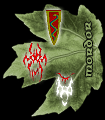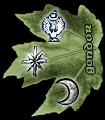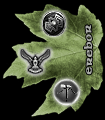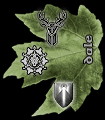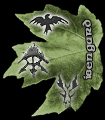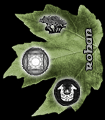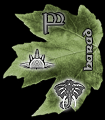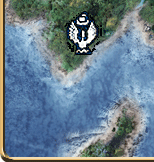|
"But when dark things come from the houseless hills, or creep from sunless woods, they fly from us. What roads would any dare to tread, what safety would there be in quiet lands, or in the homes of simple men at night, if the Dúnedain were asleep, or were all gone into the grave?" - The Fellowship of the Ring. The Dúnedain of the North, or simply "Rangers" as they are mostly refered to, are the remnant of the once great people of Arnor, they are now a wandering and scattered people. Silently protecting the simple folk of Eriador against the evils of the North. Arnor was founded at the end of the Second Age SA 3320 by Elendil, whose sons founded Gondor at the same time. The history of the two kingdoms is intertwined; both kingdoms are known as the Realms of the Dúnedain in Exile. Before the foundation of Arnor there was already a sizable Númenórean population living there, a result of the slow emigration of Númenóreans which had started under Tar-Meneldur and Tar-Aldarion. Before the arrival of the Dúnedain Arnor was home to Middle Men of Edain stock, and the early colonists soon interbred with the indigenous population. Arnor was originally favoured over the more southern regions (Gondor) because the Elves under Gil-galad lived near it across the river Lhûn. However, in later days after the Númenóreans fell under Sauron's shadow they settled more to the south. This led to a situation where Elendil arrived in an area populated by people who, unlike his own Númenóreans, were mainly still friends with the Elves, and unlike Gondor to the south in Arnor much knowledge of the Elder Days was preserved. Arnor's second king Isildur (also King of Gondor until he granted the title to Meneldil, Anarion's nephew) was killed in TA 2 by Orcs in the disastrous Battle of the Gladden Fields. His three eldest sons were killed with him, but the fourth and youngest, Valandil, survived and became king of Arnor in TA 10. Arnor's capital was Annúminas on Lake Evendim, but by TA 861 the capital was moved to Fornost Erain ('Norbury of the Kings'). During the reign of Eärendur his sons were in open discord, which erupted into civil war after Eärendur's death in TA 861. Amlaith, the true heir to the throne of Arnor, was opposed by his two brothers. Unable to resolve the situation, he was reduced to ruling the region of Arthedain, which consisted approximately of the lands west of Baranduin and north of the Great East Road. (His brothers created the kingdoms of Cardolan and Rhudaur to the south.) The kingdom's capital was at Fornost, and Bree one of its important towns. Annúminas was in the territory of Arthedain, but mostly abandoned and falling into ruin. In TA 1300, the kingdom of Angmar appeared at Arthedain's north-eastern border. Its King was the chief of the Ringwraiths, although this was not known to the Dúnedain. When this new threat came Cardolan placed itself under the suzerainty of Arthedain, which then began to call itself Arnor again. Rhudaur however fell to Angmar as the Dúnedain there declined rapidly, until a chieftain of the Hillmen took up the throne there. The Dúnedain of Rhudaur were either slain or driven into the other surviving realms. Rhudaur later became a mere province of Angmar and often joined together against Arthedain and Cardolan. Cardolan repeatedly sent aid to Arthedain when needed but by TA 1409 Cardolan was devastated by Angmar and it's last population destroyed by the Great Plague. Arthedain kept up the resistance against Angmar for over 500 years but in TA 1974 Arthedain was overrun and Fornost fell into the hands of Angmar. It fell just one year too soon, for help was underway from Gondor under the lead of Eärnur. The army of Gondor reached Arthedain in TA 1975, and they together with the elves of Mithlond and Imladris under Cirdan and Glorfindel and the survivors of Arthedain under Aranarth destroyed Angmar at the Battle of Fornost and the Witck-king retreated to the South and later captured Minas Ithil which was renamed Minas Morgul. It's last King, Arvedui drowned at Forochel in a storm together with two of the northern Palantiri just before the battle was fought. The kings of Arthedain were also the lords of The Shire and the Shire chose the Thain to replace the kings. The son of Arvedui, Aranarth decided not to rebuild the kingdom and so became the first Chieftain of the Dúnedain. From him Aragorn is descended. The survivors of Arthedain formed the Rangers of the North, an elite group of men who patrolled the lands of Eriador (which includes the Bree-land and The Shire) and kept all good folk safe from evil. They were often shunned by the same people that they protected, but they would not have it otherwise, for the lives of the simple they deem should be kept simple. They also remained in close contact with the Elves of Rivendell and Lindon, who they would seek or offer aid of. Gandalf the Grey was also an ally and companion to them and was became a close companion with their leader. Although the realm of Angmar was destroyed, evil creatures still roamed the lands of Eriador. Wolves, Trolls, orcs and creatures more foul infested the wilderness and hills of the North. Several of the Chietains of the Dúnedain had fallen victim to these creatures, which included Aragorn's father Arathorn, who had only been chieftain for 3 years, was slain by an arrow while hunting orcs with the sons of Elrond. Before the War of the Ring, the Dúnedain doubled their guard on the borders of The Shire, since Gandalf had informed them that danger was drawing near and the Ringbearer was to set out. In TA 3018 August 22 the Nazgul made their way through Sarn Ford, there they gave battle with the Rangers. Though the Dúnedain fought valiantly while day lasted, they were however over-matched by all the Nine and they were either slain or fled, tidings of this later reached Rivendell. The Dúnedain of the North played a great part in the War of the Ring. Upon hearing of Aragorn's summons by Galadriel, Halbarad Dunadan, kinsman of Aragorn, led the Grey Company - a company of Rangers of no more than 31 members - south to his kinsman's aid. They were also accompanied by the sons of Elrond. After reaching Aragorn near the Fords of Isen, they followed him through the Paths of the Dead, through Southern Gondor and fought at Pelargir and the Pelennor Fields (where Halbarad was slain) and later at the Morannon. Many of the Rangers who did not accompany Halbarad south also defended the lands around Rivendell and Rhudaur from mountain-orcs issuing from the Misty Mountains. After the War and the Reunion of the two Kingdoms by King Elessar, the Rangers once again returned to Eriador, where they maintained order in the refounded Northern Realm. After the fall of the Northen Kingdom, the surviving Dúnedain population became largely scattered, their population dwindling to no more than 500. Bereft of a kingdom, they roamed the wilds without any permenant home, though they had a few noteworthy posts throughout Eriador. They guarded the Sarn Ford along with the borders of the Shire and Bree-land, and also made occasional visits to Weathertop and the ruins of Fornost Erain. But the chief dwelling where most of their women and children were kept was in the region known as the Angle in southern Rhudaur. The Angle was located between the Hoarwell(Mitheithel) and Loudwater(Bruinen) where the two rivers converged. After the North-kingdom of Arnor was divided into three kingdoms in TA 861, the Angle was part of the Kingdom of Rhudaur. Around TA 1150, some of the Stoors who came over the Redhorn Gate moved into the Angle. But around TA 1356, as the Witch-king of Angmar's power grew and Rhudaur came under his influence, the Stoors left the Angle. Some Stoors fled west and south and others returned to Wilderland. During the end of the Third Age, Aragorn's people largely dwelt here. It's proximity to Rivendell could be a reason why the Dúnedain largely dwell here, as their chieftains were raised in Rivendell by Elrond. The Rangers of the North are grim, quiet and have become mostly a wandering and solitary people preferring in secrecy and guise rather than in open confrontation. Tall, lordly and worn as weathered rocks, they wear little to no armour and carry only one or two types of weapons. They wear tattered garments of green and dark-grey made of leather, and bear no ornaments on their garments save a silver brooch star clasped on the left shoulder of their cloaks which signifies the Star of the North, the symbol of the Lost Realm of Arnor. They wield bows, swords and spears with deadly efficiency and are unmatched in by all other men, and even the Rohirrim seemed as boys compared to them. They also raise stout horses, bred in the North, they could even be a match for the Mearas of Rohan, for they could go on for days without rest at a great pace. They are the most woodcrafty hunters of all men, save the Druedain, for they are trained since early childhood the art woodcraft, warfare and hunting. The Dúnedain are also the most hardy of all men and the least likely to fall weary in battle, for this reason, each of the Rangers are great representaions of nobility and heroism. |

